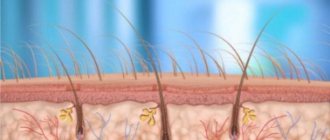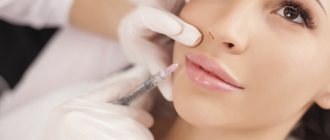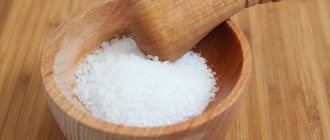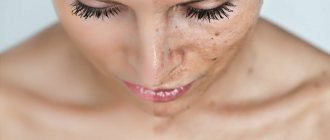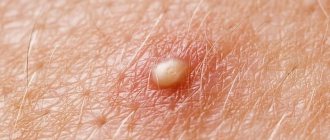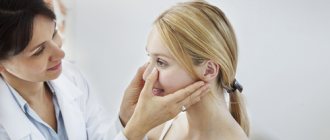Reasons for appearance
Any rash on the skin, from a small, barely visible, non-inflamed rash, to a huge volcano, signals a malfunction of the body.
A pimple is an inflammation that occurs for various reasons, caused by the synergism of excessive activity of the sebaceous gland and the blockage that forms at its outlet.
Causes:
- hormonal imbalance, characterized by an increase in male sex hormones (testosterone) and a decrease in female sex hormones (estrogen, progesterone). It manifests itself especially clearly in adolescence and is a regular occurrence in women; it is extremely rarely observed in adult men;
- disruption of the gastrointestinal tract. There are even maps of the location of acne on the face and parts of the body, which are a manifestation of a malfunction in any part of the gastrointestinal tract. To achieve a response to the disorder, the body sends toxins into the skin, and the epithelial cells react by causing acne;
- thickening and modification of the outer layer of the epidermis, called hyperkeratosis;
- dyslipidermia - a failure in the production of organic compounds (phospholipids, cholesterol, fatty acids, triglycerides) due to the synthesis of others;
- stress, which promotes the production of the hormone Cortisol, slows down protein biosynthesis and suppresses collagen synthesis;
- cosmetics that promote the formation of plugs at the outlet of the sebaceous glands. The high content of mineral oils, silicone, and vegetable oils does not allow the skin to breathe and clogs the pores.
All of the above symptoms of acne deserve a visit to a doctor, they are prerequisites for the development of terrible chronic diseases.
What do doctors think?
Doctors' opinions on squeezing out the papule are divided.
In the first case, doctors absolutely vetoed squeezing out the pustule for reasons:
- Lack of sterility.
- Lack of education and qualifications.
- The possibility of causing not only scars, but also causing blood poisoning.
In the second case, if you follow the rules of the procedure, you can squeeze out pimples.
There are certain prohibitions on performing the extrusion procedure:
- Do not crush inflammation with dirty hands;
- Do not squeeze out papules in the nasolabial triangle, near the sites of large veins and vessels;
- clearly distinguish between a large pimple and other skin inflammations - boils, herpes, chickenpox, cognitive molluscum, “steroid acne”;
- Do not squeeze out immature inflammation. A mature pustule has a clearly defined white head, the surface is dry, and has no sticky discharge.
How to tell if a pimple is ripe
Before getting rid of a pimple, it is important to understand that it has already matured.
- Squeezing out pus located deep under the skin will not produce results.
- In addition, this will lead to severe damage to the integument and even greater inflammation, which does not go away for a long time.
- After violent manipulation, scars and noticeable scars may remain.
There are two sure signs, the combination of which will help identify a ripe pimple:
Photo: formation of a white head
- Presence of a white head. This indicates that the pus and sebum that clogged the lumen have entered the surface layer of the skin towards the exit.
- No inflammation or redness around the formation.
If a white head appears, but the redness does not subside, then you should not touch such a pimple. You need to wait until it finally ripens.
Where is the best place to carry out the procedure?
Acne therapy is a complex process that is trusted by dermatologists, cosmetologists, and in advanced cases (furunculosis) surgeons.
Any chronic inflammation of the skin, accompanied by pain and periods of exacerbation, must be treated by a dermatologist. A competent cosmetologist will help you clean your face and hormonal acne. During the period of exacerbation of inflammation, only a dermatologist will provide assistance; a cosmetologist may not agree to cleanse the face.
If consent is received, acne removal will take place in sterile conditions under the supervision of a specialist who will give competent recommendations for further care.
Surgeons remove boils and other large inflammations, with pain, after any surgical operation a scar remains, and a postoperative period is required in the hospital.
How to squeeze out a large pimple?
When preparing for the procedure of squeezing out a pimple, you should follow the following set of rules:
- location of the pustule;
- correlation of detected inflammation to a pimple;
- maturation stage;
- skin hygiene. The surface of the skin is cleaned with a soap solution to remove existing dirt particles and degrease. Lubricated with salicylic acid, an excellent disinfectant (antimicrobial and antibacterial drug);
- preparing the skin at the location of a large pimple. Squeezing out a ripe pimple is a painful procedure, so it is better to steam and dry the skin first (your hands will slip on wet skin);
- hand hygiene;
- use of special devices and wound treatment products. Salicylic acid, cotton wool, disposable medical sterile gloves, cotton pads and swabs, chlorhexidine or hydrogen peroxide, a needle or a special loop tool for removing acne, prepare a table, a mirror and direct the light.
Is it possible to squeeze out an unripe pimple?
When deciding to squeeze out a pimple located deep under the skin, it is very important to remember the high risk of infection, even wider spread of rashes or scarring on the skin. A fully mature pimple can be squeezed out after first disinfecting your hands and treating the wound with an antibacterial solution. However, the removal of multiple formations must be entrusted to a dermatologist or cosmetologist.
I've been suffering all my life
It's been a couple of years now
Recently
There are several ways to pop a large pimple.
- Method one. With gloved hands or other protection that protects the patient’s face from damage by the nail plates, pressure is applied to an area of skin with a radius of 3 cm, the center of which is the white head. The force of internal pressure created by the fingers breaks through the top, preventing the contents from getting inside. A sure sign that the purulent contents of the papule have completely come out is blood. If you can’t squeeze it out, it means it’s not ripe and you need to wait.
- Method two. To squeeze out a large pimple, a needle heated on fire is inserted 2-3 mm into the head. Place a napkin on the pustule and squeeze it out using the first method.
- Method three. To squeeze out a large pimple, a special cosmetic loop is used. The instrument is placed on the skin so that the ripe tip is exactly in the center of the loop, then gentle pressure is applied; for a better result, the head of the pimple can be pierced.
- Leather processing. The wound resulting from squeezing out a large pimple is treated with a cotton swab moistened with hydrogen peroxide or chlorhexidine. It is better to cauterize the wound with alcohol tincture.
The damage will take 2-3 days to heal. You can carry out normal hygienic procedures that gently treat scabs with a dried crust. For skin care, use salicylic acid, and do not try to hide the area of the squeezed out pustule with masking preparations; you can carefully lubricate it with zinc ointment.
Read what causes small watery pimples on your hands. How to remove acne on forehead? More details here.
On the nose
Everyone wants to look irresistible, especially since appearance gives 100% self-confidence and when big trouble appears on the tip of your nose, the main thing is to pull yourself together and calm down. Determine by appearance whether the inflammation is a pimple.
If this is the case, it is necessary to pre-treat it with tea tree oil or Levomekol ointment, Zinc ointment or Salicylic-zinc ointment, which will either relieve the symptoms of inflammation or accelerate the maturation of the pimple, preventing the occurrence of inflammation in the neighborhood.
Attention! Squeezing pimples in the nasolabial triangle area is strictly prohibited.
On the back
In addition to the above reasons, a rash on the back can be caused by clothes, bedding, and washing powder. It is not possible to squeeze out a large pimple on the back on your own, but if it causes pain, you need to contact a cosmetologist who will clean it.
You can alleviate the condition with:
- increasing the frequency of hygiene procedures using tar soap and washcloths;
- taking a bath with added bath salts, which will strengthen the skin and dry out ulcers;
- treating areas of inflammation with salicylic acid, hydrogen peroxide, Levomekol ointment, Zinc ointment or Salicylic-zinc ointment.
On the face
The decision to squeeze a large pimple on your face may be made for the following reasons:
- inflammation is really a pimple;
- not located in the area of the nasolabial triangle or on the temples;
- ripe pustule with a large white head.
After squeezing, treat your face with chlorhexidine and apply panthenol ointment at night.
Subcutaneous
A subcutaneous or internal pimple resembles a large bump, the skin at the location is red, the sensation from the pimple is aching, slightly painful. It stays under the skin for two to three weeks and may reach the maturation stage or resolve.
To relieve pain and speed up maturation, the following recipes are used:
- Hot salt lotions (electrolyte solution). Two tbsp. l. Dissolve table salt in a glass of boiling water. Keep the lotions on the affected area while they are warm. After using this product, the pimple may resolve
- Grated raw potatoes are applied to the site of inflammation at night, the bandages are changed as the paste dries, this helps the inflammation mature and break out on its own.
- A mask made from aloe leaves promotes the maturation of inflammation and its own breakthrough.
- The use of ichthyol ointment, Vishnevsky ointment, they are united by affordability, a pungent odor and a positive effect.
The appearance of such acne is an alarming signal about a serious malfunction in the body; it is better to consult a doctor for a referral to appropriate specialists.
Subcutaneous pimple like a lump
Subcutaneous pimples are usually formed as a result of hormonal imbalance.
In males, similar rashes occur during puberty (12-20 years). An increased level of testosterone in the blood increases the activity of the sebaceous glands. This contributes to the abundant secretion of sebum, which clogs the excretory ducts. As for women, they most often suffer from rashes during menopause and due to age-related changes, during pregnancy, and breastfeeding. It is worth noting that acne can appear as a result of prolonged use of hormonal contraceptives.
https://www.youtube.com/watch?v=blNK5hI4DEY
Internal acne forms for the following reasons:
- damage to the skin in vulnerable places, for example, on the chin, cheek or forehead;
- alcohol abuse;
- smoking;
- allergy;
- violation of the water-fat balance of the skin;
- unbalanced diet, consumption of fast food;
- improper hygiene of the face and body;
- use of incorrectly selected cosmetics;
- decreased local immune system;
- severe stress, prolonged stay in a state of stress.
Main symptoms
We will learn how to get rid of this unpleasant phenomenon later, after we become familiar with the developmental features and symptoms of internal pimples.
A huge number of microorganisms live on the surface of a healthy epidermis that are not capable of causing harm. But as a result of harmful influences, these microorganisms can turn into evil pests.
Bacteria begin to penetrate en masse into the ducts of the sebaceous glands, where there is no oxygen. Against the background of this feature, they begin to actively reproduce. This leads to physical discomfort at rest, an increase in the size of the lump and the focus of inflammation.
Treatment of this phenomenon is difficult, since the pus is not able to come out on its own. Remember that you cannot squeeze it out. There is a serious threat of massive spread of infection, and noticeable scars may remain. Waiting for the pimple to mature on its own is also not an option, since it can take quite a long time to mature. This process can be accelerated.
Internal pimple bumps cannot appear suddenly; compaction forms gradually:
- At the very beginning, a slight redness forms - this indicates that harmful bacteria have entered the skin;
- With mechanical impact, the inflamed area begins to hurt;
- Next, a small tubercle forms;
- After a while, the compaction begins to look more like an abscess.
It is recommended to start treatment at an early stage.
To quickly identify the anomaly, you should establish the cause of its appearance, and then begin complex treatment. As a rule, the complex covers the elimination of mechanical impact and injury to the source of infection, proper nutrition, and avoidance of hypothermia/overheating.
The most important thing: squeezing an immature pimple is strictly prohibited. When trying to squeeze out a pimple, the bag of bacteria and sebum can become damaged and spread under the skin, which can lead to blood poisoning, scarring after these bumps, the appearance of several new similar pimples, an increase in their size and an increase in the inflammatory process.
If a subcutaneous pimple appears on the face, it is recommended to minimize or even stop using cosmetics.
To effectively remove a subcutaneous lump, you should wait until the pus and bacteria come out in the form of an abscess. By itself, it is capable of growing for a long time. But remember that you can “push” it.
Perhaps the most popular medications are:
- Ichthyol ointment;
- Levomekol;
- Sulfur ointment, which should be applied to the inflamed area in a thin layer throughout the day;
- Synthomycin ointment promotes the resolution of inflammation or rapid maturation; it is recommended to apply several times during the day;
- Aloe is a herbal ingredient that will help get rid of pimples. To do this, we need to cut off the protective green part of the leaf, apply it to the source of inflammation and fix it with an adhesive plaster;
- Vishnevsky ointment is one of the best remedies designed to draw pus out from under the skin. Apply a small amount of ointment to a cotton pad and apply to the site of inflammation, securing with an adhesive plaster or bandage. It should be kept for no more than half an hour. We repeat the procedure until the pimple matures properly. The disadvantage of the product is its specific and pungent odor, so it is better to apply it in the evening;
- Birch tar is similar to Vishnevsky ointment and should be used in the same way.
The above drugs have worked well because they can effectively draw out pus from the layers of the skin, inhibit the spread of infection, reduce pain and relieve inflammation. If you have a pimple like a lump, we strongly recommend that you replenish your home medicine cabinet with these medications.
When treating subcutaneous acne, it is important to be careful and not overdo it. Let's take a look at the basic recommendations that will allow you to get rid of internal acne at home.
- Proper nutrition. During the therapeutic course, spicy, salty and fatty foods should be excluded from the diet. It is recommended to eat in small portions at intervals of 2-2.5 hours. If there are problems with the gastrointestinal tract, then it is better to take a course of medications aimed at restoring the natural microflora;
- Acceleration of the maturation process;
- Using high-quality (preferably completely natural) drying agents;
- Elimination of stress and healthy sleep;
- Compresses at night;
- Long walks in the fresh air before bedtime;
- Medicines, if you cannot do without them;
- Eliminating the possibility of subcutaneous mites. If it is detected, then you should strictly follow all the specialist’s recommendations. In this case, home treatment may cause more harm than good;
- Maintaining hygiene rules. Of course, cleanliness of the skin affects the treatment of acne. A clean surface of not only the skin, but also its pores will generally protect you from the appearance of problems in the form of acne. As a rule, washing your face in the morning, afternoon and evening is enough. In the evening, it is recommended to take medicinal baths with the addition of herbal ingredients;
- Ozone therapy is an effective way to treat skin problems and also helps strengthen the immune system. Accelerates the production of elastin and collagen, reduces the production of subcutaneous sebum and accelerates the regeneration of the skin. Several injections a year will improve the health of the body as a whole.
In the cosmetology office, hardware methods are used to care and treat problem skin:
- Ozone therapy, thanks to which it will be possible to destroy pathogenic/pathogenic microorganisms, relieve pain and swelling, cleanse clogged pores and saturate the facial skin with oxygen;
- Peeling (laser therapy, dermabrasion, use of fruit acids) allows you to get rid of dead cells of the upper layer of the epidermis, facilitating access of cosmetics and oxygen to living tissues;
- Elos technology is light therapy, thanks to which the processes of restoration and regeneration of the skin are accelerated, pores are narrowed and inflammation is effectively eliminated.
It is extremely important to ensure proper body hygiene during treatment; you should avoid wearing decorative cosmetics and regularly treat the affected areas of the skin with an antiseptic.
In order for the treatment to be successful and new acne not to appear, the skin should be provided with additional, and most importantly, proper care:
- wipe problem areas with products based on salicylic acid;
- refrain from visiting the solarium;
- Wash your hair separately from your body, as shampoos and conditioners clog pores;
- wear clothes made from natural materials.
It is quite difficult to get rid of acne on the back due to their inaccessibility, because in this case it is difficult to make compresses yourself.
- Coconut oil effectively dries out rashes and can be used to lubricate the entire body, including the face;
- To combat internal acne, you should take baths. Sea salt and chamomile decoction should be added to a warm bath.
Due to the fact that the skin on the body is rougher, getting rid of acne is not so easy.
Treatment should cover a complex of all possible measures:
- proper nutrition;
- antibacterial ointments;
- compresses at night;
- medicinal baths;
- surface disinfection;
- skin cleansing.
https://www.youtube.com/watch?v=JBsdGlZBTBo
The process of formation of subcutaneous skin is directly related to the excessive production of sebum, which accumulates in the sebaceous ducts. It is a breeding ground for bacteria that multiply inside the sebaceous glands and provoke subcutaneous inflammation. As a result of the inflammatory process, a hard ball (bump) appears on the skin, which hurts when pressed and, unlike skin rashes such as pimples or acne, is not squeezed out in the usual way.
Inflammation affects the inner layers of the skin, and its superficial keratinized layer creates an obstacle to the normal cleaning of the sebaceous ducts. For this reason, it is difficult to get rid of subcutaneous acne, whether it is small white rashes or one large inflamed subcutaneous area. Such formations are located in the deep layers of the skin and “ripe” for a very long time, and therefore it is impossible to remove accumulations of sebum and pus from them using conventional methods.
Why is it dangerous?
We are taught to crush acne in adolescence by our mothers, and in rare cases, by fathers. After fruitless attempts to escape from the suffocating maternal grip, we resign ourselves, endure the pain and learn, thinking that we will not cause ourselves such pain.
Having become involved in the process, we regularly squeeze them ourselves; doctors, on the contrary, consider squeezing out pimples a dangerous undertaking for the following reasons:
- Mechanical damage to the walls of dilated blood vessels.
- Injury to the sebaceous gland.
- Scars, scars, depressions and spots, the consequences of squeezing out pimples.
- A wound open to infection.
- Infection through hands.
- When you smear the contents of an eel on your face, you can get furunculosis.
- When pressure is applied, the contents of the pimple come out both out and in. Pus, entering the bloodstream, spreads throughout the body, causing inflammation and even the formation of blood clots. The vessels on the face are closest to the brain; purulent contents with blood enter directly into the brain, causing inflammation of the meninges and sepsis.
There is an opinion among doctors that the pustule itself is located in a protective barrier created by the body, so it is better to leave its destruction to specialists.
What to do if you have a pimple
The first thing that comes to mind for many girls is to squeeze out a pimple as quickly as possible.
However, this is exactly what you should absolutely not do! Especially when the pimple has not yet fully matured. Firstly, this will not be possible - the contents of the pimple simply will not come out, since it is located in the deep layers of the epidermis. Secondly, such manipulations will lead to severe local damage to the skin, which will inevitably result in even greater inflammation, redness of the skin, and damage to it. In addition, this can lead to a cosmetic defect in the form of post-acne (spots), a scar or scar that remains if pimples are squeezed out. Therefore, the first rule is not to push! The second rule concerns steaming your face. This procedure actually promotes the maturation of inflammatory elements by increasing blood circulation. But you can’t do it for inflamed pimples because there is a risk of spreading the infection throughout the face, thereby only aggravating the situation by causing even more pimples.
You can speed up the maturation of a pimple without the risk of such unpleasant complications. The remedies are usually applied locally to the inflamed area.
Treatment
Sequence of stages of acne treatment:
- preventing the appearance of new acne. Changes in diet, refusal of harmful cosmetics;
- Women must remove makeup from their face at night;
- removal of mature acne;
- reduction of sebum production - hormonal therapy;
- ultrasonic facial cleansing;
- peeling is a procedure for grinding the layers of skin (epidermis) in order to resume metabolic processes. When treating acne, the following are used: cosmetic exfoliation of the top layer of skin, enzymatic cleansing, chemical burns.
- treatment with antibacterial drugs internal and external;
- eliminating the consequences of acne using cosmetic procedures, laser resurfacing, cryotherapy, etc.;
- bringing body systems back to normal: restoring the functioning of the gastrointestinal tract, normalizing hormonal levels, treating stress.
Initially, adjust to the duration of treatment, since the symptoms of early acne prevention were missed.
How to cleanse and soothe your skin
At home, the following recipes are used to cleanse the skin:
- A solution of salicylic acid, streptocide 1 sachet of 10 g each, 5 crushed tablets of chloramphenicol are poured into a prepared dark glass bottle with a lid. The mixture is thoroughly shaken and applied pointwise to the affected areas. Use once at night for three days, then break for 2 days and continue according to the scheme. Used until complete recovery. You can moisturize your skin with panthenol ointment.
- The chatter ointment, prepared on the basis of zinc and freely sold in pharmacies, is excellent for drying out pimples.
- Creams that cleanse the face: Baziron, Klerasil, Klenzit, Differon, Zinerit, Syntomycin ointment.
The effect of ointments is individual; you need to choose a remedy that is effective for your inflammation, taking into account the difference in price range.
How to relieve inflammation
The most effective treatment for a pimple is at its inception.
The main thing is to know what to apply so that the redness goes away. Some products are so strong that they can completely remove acne in 2-3 days.
To relieve inflammation, pharmaceutical preparations with drying and healing properties are used:
- Reddened areas are spot-treated with salicylic acid. But here it is important not to overdo it and not burn the covers, otherwise marks will remain. You can use special cosmetics for the care of problem skin based on salicylic acid. These include cleansing gels, tonics and lotions. It is better to choose alcohol-free products;
- Aspirin helps some. Crush the tablet into powder, add a drop of water and apply the resulting mixture to the pimple;
- Calendula tincture with alcohol is applied to the inflamed area 2-3 times a day;
- Boro Plus cream has a good healing effect. This Indian herbal preparation is used in beauty salons to speed up skin healing after various procedures. The cream is spread in a thin layer over the entire face;
Photo: pharmaceutical products for the treatment of acne
- To dry a pimple, apply zinc ointment 2-3 times a day, always at night. Due to its dense consistency, the product does not spread and does not stain clothes and underwear;
- many use vasoconstrictor nasal drops to relieve inflammation (Naphthyzin, Vizin, Galazolin). The solution is dripped directly onto the reddened area;
- Locally, acne is treated with essential oils (tea tree, rosemary, eucalyptus, rose, wheat germ). To rid your face of redness, you need to make a mask from white clay, adding a drop of oil to it;
- "Dimexide" is also known for its anti-inflammatory effect. One part of the solution is diluted with three parts of clean water and the pimples are burned using a cotton swab. The product should be used with caution to prevent severe burns;
- You can use prednisolone ointment once. This is a hormonal drug that resolves internal acne. But it is addictive, so you cannot process more than 3 formations at the same time;
- A safe method is to apply a cut of an aloe leaf to the sore spots. Compresses can be done as many times as you like, there will be no harm from them.
Photos before and after
To soothe the skin after such cleaning, a recipe is used: wipe the inflamed areas after cleaning with miramistine or chlorhexidine, then apply panthenol ointment.See the causes of internal acne on the face. All about acne on the cheeks. Find out further.
Why do newborn acne appear?
The answer is here. If the appearance of acne on the face and body is regular with periods of remission and exacerbation, you should not squeeze them out, but find the time and consult a dermatologist for advice. Having received competent recommendations from specialists, you can get rid of skin rashes.
